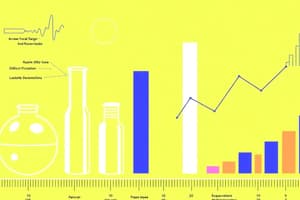Podcast
Questions and Answers
In experimental research, what does the researcher manipulate?
In experimental research, what does the researcher manipulate?
- The control group
- The extraneous variables
- The independent variable (correct)
- The dependent variable
What is a key characteristic of a true experimental design regarding subject assignment?
What is a key characteristic of a true experimental design regarding subject assignment?
- Subjects are assigned via a lottery system.
- Subjects are randomly assigned to groups. (correct)
- Subjects are assigned to groups non-randomly.
- Subjects are assigned based on convenience.
In a control group, what typically happens?
In a control group, what typically happens?
- Receives a placebo effect
- Receives the experimental treatment
- Receives no treatment (correct)
- Receives a different experimental treatment
Which design involves neither a control group nor random assignment?
Which design involves neither a control group nor random assignment?
In research design notation, what does 'X' usually represent?
In research design notation, what does 'X' usually represent?
What is the primary data collection method in survey studies?
What is the primary data collection method in survey studies?
In which type of study has the outcome of interest already occurred when the study begins?
In which type of study has the outcome of interest already occurred when the study begins?
In what time frame is data collected in a cross-sectional study?
In what time frame is data collected in a cross-sectional study?
Which study design involves collecting data from the same individuals at different points in time?
Which study design involves collecting data from the same individuals at different points in time?
What is the aim of a descriptive study design?
What is the aim of a descriptive study design?
What is the purpose of a comparative study design?
What is the purpose of a comparative study design?
Which research design investigates the direction and magnitude of relationships among variables?
Which research design investigates the direction and magnitude of relationships among variables?
What type of design is used to judge the worth or value of a program or service?
What type of design is used to judge the worth or value of a program or service?
Flashcards
Independent Variable
Independent Variable
Researcher manipulates this variable in an experiment.
True Experiment
True Experiment
Experimental design with random assignment, control group, and manipulation of independent variable.
Control Group
Control Group
A group that does not receive the treatment in an experiment.
Random Assignment
Random Assignment
Signup and view all the flashcards
Quasi-Experimental Design
Quasi-Experimental Design
Signup and view all the flashcards
Research Design
Research Design
Signup and view all the flashcards
Survey Studies
Survey Studies
Signup and view all the flashcards
Retrospective Study
Retrospective Study
Signup and view all the flashcards
Cross-Sectional Study
Cross-Sectional Study
Signup and view all the flashcards
Longitudinal Study
Longitudinal Study
Signup and view all the flashcards
Descriptive Design
Descriptive Design
Signup and view all the flashcards
Comparative Design
Comparative Design
Signup and view all the flashcards
Correlational Design
Correlational Design
Signup and view all the flashcards
Study Notes
- Chapter 3 addresses how researchers answer questions from Chapter 1, focusing on methods and data sources for study.
Methods of Study and Sources of Data
- Key elements include research design, study respondents, data-gathering instruments and procedures, and statistical treatment.
Research Design
- Research design is the framework of research used for a study
- Descriptive design is observational, describing 'what is' without controlling variables.
- Correlational design explores relationships, not causality, among variables without control.
- Quasi-experimental designs test causality with limited variable control, without manipulating the independent variable.
- Experimental designs test causality with optimal variable control, manipulating the independent variable.
Non-Experimental Designs
- These designs include survey studies and various time orientations such as retrospective, cross-sectional, and longitudinal.
- They also have different purposes or objectives (descriptive, comparative, correlational, and evaluative).
Survey Studies
- Conduct investigations through self-reporting to understand attitudes, perceptions, or behaviors.
- Aim to define traits, views, and qualities as they naturally exist within a group.
Time Orientation
- Retrospective studies examine outcomes that have already occurred.
- Cross-sectional studies gather data at a particular moment with subjects at different experience phases.
- Longitudinal studies collect data from the same subjects over time.
Purpose or Objective
- Descriptive designs gather information on characteristics in a specific field.
- Comparative designs assess samples from two or more groups.
- Correlational designs explore the direction and magnitude of variable relationships in a population.
- Evaluative designs judge worth or value, providing input for programs or services, and can be formative or summative.
Experimental Designs
- True experimental design contains researcher manipulation of the independent variable.
- True experimental design involves random assignment of subjects with experimental and control groups, the latter receiving no treatment.
- Pretest-posttest control group design includes random selection, pretests, intervention (X), and posttests for both experimental and control groups.
- Posttest only control group design includes random selection (R), intervention (X), and posttest (O2) for the experimental group, and just the control group.
- Solomon four-group design includes random selection (R), pretests (O1), intervention (X), and posttests (O2) across four groups.
- Quasi-experimental design lacks a control group or random subject assignment.
- Non-equivalent control group design includes pretests (O1) and posttests (O2) for both experimental and control groups, with intervention (X) for the experimental group.
- Time-series design includes multiple pretests (O1, O2, O3), intervention (X), and posttests (O4, O5, O6).
- Pre-experimental design has limited researcher control and is considered weak.
- One-shot case study involves one group receiving a treatment (X) followed by an observation (O).
- One-group pretest post-test design studies a single group, measuring them before (O1) and after (O2) an intervention (X).
Studying That Suits You
Use AI to generate personalized quizzes and flashcards to suit your learning preferences.




